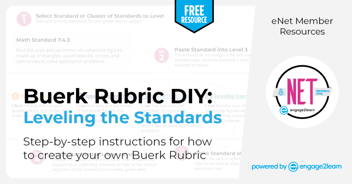Critical Analysis Best Practices | engage2learn
Humans analyze almost constantly throughout our day. We ask ourselves numerous questions as we plan our actions. What time do I need to leave to get to work? How do I phrase something in a meeting?
Adults aren’t unique in our capacity to analyze. Both elementary and secondary students analyze the world around them. One task of the education system is to teach these learners how to do Critical Analysis, both in the classroom and in their daily lives.
We asked our experienced e2L Certified eGROWE© coaches to weigh in on best practices for Critical Analysis at both the elementary and secondary levels.
See what they have to say!
Kalinda Witty

Elementary students can easily recall, or rename, but how do we shift the focus onto incorporating intellectual challenges and activities that will provide children with opportunities for original work?
As El Paso ISD [grade] teacher Mrs. Ratzlaff states, “It has to be modeled so we, as educators, need to help students gain better control of their own learning.”
For the critical reflection outcome, we can embed higher order question stems into our lesson planning. As young learners find and use information to begin problem solving, the critical feedback will be an imperative piece of the learning process. Feedback stems for learners will help model this step in order to ensure that the quality of feedback is beneficial to the recipient.
In the podcast Moving Feedback to Feedforward, the author explains the powerful impact we can have on our students when we focus on the future. Before long, the deeper understanding will develop more autonomous thinkers.
Teachers also benefit from students thinking more critically. Click To TweetTeachers also benefit from students thinking more critically. It improves the depth of classroom conversation. In fact, see what Zach White Elementary teacher Elizabeth Ratzlaff thinks of her students’ critical analysis skills, and how they benefit from them:
“One benefit would be the ability to make connections on a global scale. Such as when a simple task like a human model of energy transformation in a cell phone raises awareness of overuse and dependency on fossil fuels as a form of energy.” – Elizabeth Ratzlaff (Zach White Elementary, El Paso ISD)
Christin Leggett

It’s no surprise that Critical Analysis often tops the list of college and career readiness skills and remains a Best Practice in most educational climates.
However, defining this fundamental attribute and pinpointing successful implementation measures are more elusive. Traditionally, Critical Analysis has often been inferred, with us—the educators—assuming that students synthesize information on a deeper level than they likely do.
My secondary educational experience was a perfect example of this. I was an ideal student by all accounts with near-perfect grades and a flawless record. However, it wasn’t until I became a young adult when I learned to truly think critically… a developed skill that eventually led me into this meaningful field, though the journey was long and winding.
Imagine the possibilities for a student who develops this Life-Ready Skill as a young learner: a student who analyzes, questions, reflects, and applies his or her academic experiences.
Promoting Critical Analysis in the classroom is imperative, but how can one approach such a multi-faceted concept, especially with primary students?
In one word: trust … in your students and in yourself.
Trust that you may not always have all of the answers, and that’s okay. Click To TweetTrust that you may not always have all of the answers, and that’s okay. In fact, it’s ideal, since fostering Critical Analysis in young learners begins with you becoming their facilitator rather than a supplier of information.
Additionally, get to know your students on a deeper level. Discovering what interests them most will, in turn, make their learning experience more meaningful. Relevance is a powerful tool for any age group! Tap into any available resources, from technology applications to field experts. No exploratory task of research is too small.
Lastly, make Higher-Order Thinking commonplace in your daily conversations with students. Helping them to make real-world connections to their learning is key! Release the reins and GROW critical thinkers at every level.
Olive May

Critical Analysis, research, and inquiry is essential in every grade level, which is why it is important to set the foundational skill of critical thinking early on.
Designing opportunities for learners to research curiosities aligned with standards and establishing what they know and what they need to know leads to student engagement. When students conduct research that is based on their interests, learning becomes relevant, authentic, and purposeful.
Providing research question sentence stems is crucial to ensure their research leads to developing higher order thinking skills. For lower grades, I have observed the utilization of atypical resources such as Skyping experts in the field, interviewing campus personnel, or inviting community members to share their expertise heightens the learner engagement and experience in the classroom environment.
The interactions that occur in preparation to collaborate with experts contributes to the effectiveness of Critical Analysis, especially when using leveled questions to prepare for the conversations and interviews with guests.
Facilitating students in practicing Critical Analysis will strengthen students’ ability to think critically and will serve as a Life Ready Skill that will help them be successful in life.
Facilitating students in practicing Critical Analysis will strengthen students’ ability to think critically. Click To TweetThe Bottom Line
Research shows that only 5% of teacher directed questions are higher-order divergent (Wilen, 1987). While we know that asking multiple types of questions is good pedagogy, the research indicates that we consistently revert to asking lower level convergent questions far more often than any other type of question.”
So, planning for critical thinking is… critical!
How do you foster Critical Analysis in the classroom? Let us know in the comments.



